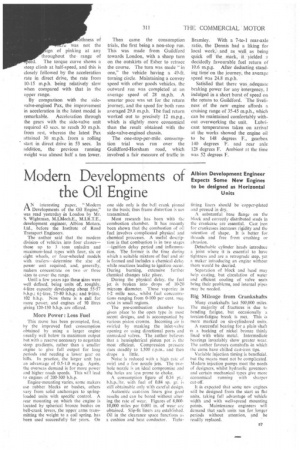Modern Developments of the Oil Engine
Page 41

If you've noticed an error in this article please click here to report it so we can fix it.
Albion Development Engineer Expects Some New Engines to be designed as Horizontal Units
AN interesting paper, "Modern Developments of the Oil Engine," was read yesterday in London by Mr. S. Wightman, M.I.Mech.E., M.I.R.T.E., development engineer, -Albion Motors, Ltd., before the Institute of Road Transport Engineers.
The -author said that the modern division of vehicles into four classes— those up to .3 tons unladen and inaximurn-load types with four, six or eight wheels, or four-wheeled models with trailers—determine the size of power unit required, and, generally, makers Concentrate on two or three sizes to cover the range.
Until a few years ago these sizes were well defined, being units of, roughly,
4-litre capacity developing about 55-57•h.h.p.; 6-litre,. 75-80 b.h.p.; and 9-litre,
102 b.h.p. Now there is a call for more power, and engines of 10 litres giving 120-130 b.h.p. are offered.
More Power : Less Fuel This move has been prompted, first, by the improved fuel consumption obtained by using a larger engine usually well below its maximum output hut with a reserve necessary to negotiate steep gradients, rather than a smaller engine to give full output for long periods and needing a lower gear on hills. In practice, the larger unit has an advantage of 0.5-1.0 m.p.g. Again. the overseas demand is for more power and higher roads speeds. This will lead to engines of 200-300 b.h.p.
Engine-mounting varies, some makers use rubber blocks or bushes, others vary front solid anchorages to springloaded units with specific control. A rear mounting on which the engine is located by spherical bronze bushes on bell-crank levers, the upper arms transmitting the, weight to a coil spring, has been used successfully for years. On
one side only is tlhe bell crank pinned to the bush; thus frame distortion is not transmitted.
Most research I has been with the combustion chamber. It has recently been shown that tie combustion of oil fuel involves complicated physical and chemical process; A useful description is that comb tion is in two stages --ignition delay period and inflammation. The former is the time during which a suitable Mixture of fuel and air is formed and inclUdes a chemical delay while reactions leading to ignition occur. During burning, extensive further chemical changes take place.
During the physical delay, the fuel jet is broken into drops of 10-20 microns diameter. These vaporize in 1-2 male sees., whilst fuel concentrations ranging from 0-100 per cent. may exist in small regions.
The pre-combustion chamber has given place 'to the open type in most recent designs, and is accompanied by various piston crowns. Incoming air is swirled by masking the inlet-valve opening or using directional ports and unmasked valves. The author believes that a hemispherical piston pot is the most efficient. Compression pressure rises steadily to 1,500 r.p.m., and then drops a little.
Noise is reduced with a high rate of swirl and a few nozzle jets: The twohole nozzle is an ideal compromise and the holes are less prone to choke.
A consumption figure of 0.34 pt./ b.h.p/hr. with fuel of 0.84 sp, gr. is still obtainable only with careful design.
AuStenitie cast-iron liners give good results and can be bored without altering the rate of wear. Figures of 8.00010,000 miles per 0.001 in. of wear are obtained. .Slip-fit liners are established. Oil in the clearance space functions as a cushion and heat conductor. Tight titling liners should be Copper-plated and pressed in dry.
A substantial base flange on the block; and correctly -distributed studs in the crankcase are essential. Cast iron for crankcases increases rigidity and the retention of shape. It is better for threads and free from crushing or abrasion.
Detachable cylinder heads introduce a joint where it is essential to have tightness and are a retrograde step, yet a maker introducing an engine without them would be decried.
Separation of block and head may help casting, but circulation of water and efficient cooling of valve seats bring their problems, and internal pipes may be needed. .
Big mileage from Crankshafts
Many crankshafts last 500,000 miles. The majority of fractures is due to bending fatigue, but occasionally a torsion-fatigue break is met. This is more marked on six-cylindered units.
A successful bearing for a plain 'shaft is a backing of nickel bronze thinly lined with white metal. Intermediate bearings invariably show greater wear. The author favours camshafts in which the cams have chilled cast-iron tips,
Variable injection timing is beneficial, but the means must not be complicated. Modern injection pumps meet the needs of designers, whilst hydraulic governors and certain mechanical types give MON economical running with sharper cut-off.
It is expected that some new engines will be designed from the start as flat units, taking full advantage of vehicle width and with well-spread mounting points. Maintenance engineers will demand that such units run for .longer periods without attention, and he readily replaced.




















































































